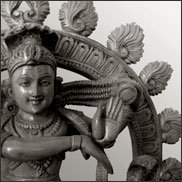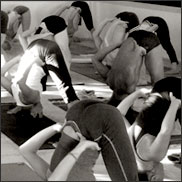Ashtanga Yoga
Ashtanga Yoga (also known as 'Ashtanga Vinyasa Yoga') is a dynamic form of Hatha Yoga taught by Sri K. Pattabhi Jois in Mysore, India.
Yoga
All of the peace, happiness and wellness you seek reside within you. Your true nature is perfect health, vitality and joy. From this fountain of wellbeing you emerged into physical life.
Every one of us remains connected to this source of Divine Wellness in every moment of every day, yet many of us still experience significant amounts of physical, emotional and mental discomfort – the very opposite of wellbeing! This is because, for one reason or another, these essential aspects of our being have been thrown out of balance, limiting the flow of wellness that can flow into our lives.
The word Yoga means ‘union’, which refers to the profound state of connectedness and peace that naturally arises within oneself when it is practiced. As well as rebalancing the physical body Yoga also has a transformative effect upon every other aspect of your Being; with steady and committed practice manifesting less self-importance, less material attachment, more capacity for joy, greater forbearance, and more tolerance toward others.
Yoga is about creating and maintaining balance;
balance in the Mind, balance in the Body,
and balance in the Soul.
Ashtanga Yoga
Ashtanga Yoga (also known as 'Ashtanga Vinyasa Yoga') is characterised by its focus on vinyasa (synchronised breath and movement), that creates a constant flow between the more static, traditional yoga postures. It is a dynamic system that emphasises the connection between breath and movement through a series of postures specifically designed to balance strength and flexibility, whilst simultaneously focusing and calming the mind. Through its flowing style and use of the ujjayi breath and bandhas (gateways that regulate the flow of energy around the body), Ashtanga creates heat in the body that stimulates the nervous system and burns through blocks in the body to release latent life force energy.
The Ashtanga Vinyasa practice was passed down through an ancient lineage of gurus to Sri Krishnamacharya – known to many as the grandfather of yoga – by his guru Sri Brahmachari during 7 years of study in a cave at the foot of Mount Kailash. This wisdom later passed to his student of 25 years Sri K. Pattabhi Jois, who at the age of 92 still teaches the Ashtanga system to thousands of students from across the globe every year from his home in Mysore, India.
Traditionally Ashtanga is taught in a Mysore-style environment, where each student practices the sequence according to their own individual capacity. Practice is based upon each person’s physical ability, so it accommodates all levels. Beginner students will likely have a much shorter practice than more experienced ones, and then slowly, when the teacher sees that the student is ready, additional poses are added to the routine, building stamina, strength, flexibility and concentration but without overexertion or risk of injury. Over time as the breath and mind become strong the Ashtanga practice becomes a meditation in motion.
Although Ashtanga Vinyasa Yoga is an ancient spiritual practice it is not directly affiliated with any one religion, so you do not need to alter your belief system to enjoy yoga.
When we begin to practice yoga it is inevitable that we will compare our abilities with those of others, but yoga is not about competition. You cannot be ‘good’ at yoga, nor can you ‘succeed’ at yoga, everyone is different and everyone will practice yoga differently. True yoga is a journey of self-discovery and a profoundly individual experience. It teaches us to surrender our ‘ego’ and move beyond our limitations into a whole new way of experiencing life.





